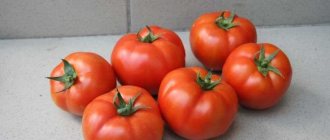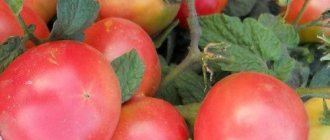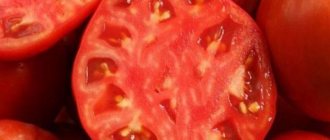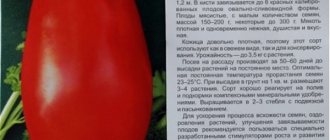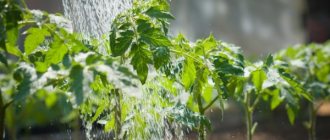Eagle Heart
A tomato with the proud name Eagle Heart occupies the bottom line of our top.
Everyone who grows these giant tomatoes with an elongated tip, shaped like a heart, leaves only positive reviews about it. The weight of the fruit reaches 600-800 g, and sometimes up to 1 kg. One such pink-raspberry fleshy “bug” - and you can feed the whole family with salad! The tomato pulp is sugary, juicy and sweet. The variety is determinate, has a medium ripening period - in a greenhouse with nutritious soil the bushes grow up to 170 cm and require pinching and staking. In open ground they may be slightly lower. But their yield sometimes exceeds 10 kg per bush. For the sake of such impressive results, no effort is spared. Moreover, the tomato shows resistance to most diseases, does not lose its shape during transportation and can be stored for up to 3 months.
The bronze “medal” and 3rd place in the ranking goes to Eagle’s Beak, popular among many tomato growers! The variety is mid-season (110-115 days), semi-determinate - the height of strong bushes reaches 120-150 cm. Proper shaping, tying to a trellis and timely pinching will help them develop harmoniously and bear fruit well. Under ideal conditions and with proper agricultural technology, the yield can be up to 8 kg per bush.
“Eagle beak is the best, I have no competition yet, the leader for today.” Olga Nesmeyanova.
The fruits are large, of unusual shape, with an elongated and curved tip, similar to a beak. On average, they weigh 200-400 g, but some grow up to 800 g. The pulp is dense and juicy, with a sweetish taste.
The variety is resistant to the main nightshade diseases - late blight, fusarium and tobacco mosaic virus. Tomatoes tolerate transportation well due to their thick skin and do not crack during canning.
“I really like Eagle Beak!!!” Nina Belevtseva.
The absolute leader in the popular rating of tomatoes, which received a record number of votes, is the generally recognized and most popular variety, Bull's Heart! A real Senor Tomato in all respects!
The variety is late-ripening - the first fruits (5 pieces in a cluster) ripen 120-130 days after emergence. In open ground, the yield ranges from 3 to 5 kg of tomatoes per bush. In a greenhouse, this figure can increase to 12 kg. Determinate type bush - stems grow up to 1.5 m or more. To achieve record harvests, do not neglect care - timely shaping and tying to the support, preventive treatment against late blight - and the harvest will not keep you waiting!
Koenigsberg
A mid-season variety of indeterminate (up to 2 m in height) tomatoes, which confidently took 10th place in our amateur rating. The first fruits usually ripen 110-115 days after sowing the seeds. Even beginners can cope with their cultivation. The variety has been tested and hardened in the harsh conditions of Siberia. Therefore, you can safely plant these tomatoes in open ground. Their productivity indicators are impressive - from 4 to 18 kg per 1 sq.m.
“Konigsberg performed well both in the greenhouse and in the OG.” Yuri Kuzminykh.
The oblong fruits ripen in clusters of 6 pieces, they weigh on average 300 g, under favorable conditions the weight can be 2-3 times higher than the standard declared by the manufacturer. Both the skin and the pulp of tomatoes are dense, which makes them easier to transport. Of course, they are healthier to eat fresh, but they are also very tasty in the form of juice, thick paste or sauce. There are varieties of red and yellow color (Golden Konigsberg).
“Konigsberg is an excellent variety, it bears fruit throughout October, from one bush to 2 buckets. In the greenhouse, of course." Lyudmila Petlyuk.
Fruit characteristics
The fruits have the following commercial characteristics:
- fruit weight ranges from 95 to 105 g;
- it has a round, slightly flattened shape, similar to a sphere;
- This fruit is characterized by a bright red color;
- the fruit is very fleshy inside;
- has excellent taste, tomatoes are sweetish;
- There are 4-7 seeds inside the fruit.
The advantage of the Danna variety is that it produces high yields. You can collect from 3 to 5 kg of tomatoes from one bush. Also, its fruit is very durable, so it can be transported over long distances and will not deteriorate at all.
The fruits of this variety are very tasty because they are juicy and fleshy. This variety is also resistant to cold weather and does not require much care at all. It is resistant to various diseases that occur in tomato fruits. But in order to protect the plant from late blight, it still needs to be sprayed with special means from time to time. Maximum 3 times per season.
Experts in this field and gardeners who grew this variety claim that there are no shortcomings in this variety.
tomato Dacosta Portuguese - description and characteristics of the variety
Further care
After transplantation, the plants are not watered for a week. In the future, watering is carried out 2-3 times a week; in hot weather, tomatoes can be watered every other day.
After watering or rain, it is advisable to loosen the root zone in order to break up the dry crust that forms on the soil surface. You also need to remove all weeds.
Tomato Titan - description and characteristics of a late variety
Fertilizing is carried out several times a season, using nitroamophoska, bird droppings, and complex fertilizers.
Related article:
Tomato Red Rooster - characteristics and description of an early variety
As the shoots grow and the fruits ripen, the stems should be tied to strong supports, bushes should be formed and excess shoots should be removed as they appear.
Abakan pink
On the 9th line - a variety of medium-late ripening (110-120 days from germination), determinate type (height - 70-80 cm). In a greenhouse it can grow up to 140-150 cm. The bush needs to be formed into 1-2 stems and tied up. It will ripen pink, heart-shaped fruits (weighing up to 300 g) with tasty, dense pulp. If cared for correctly, you can harvest tomatoes weighing up to 800g, rivaling in size the popular Ox's Heart.
There are many positive reviews about growing this tomato; no one criticizes it. It can be grown in Siberia, and to protect the bushes from returning spring or late autumn frosts, a light film cover will be enough. This representative of the nightshade family rarely gets sick; you will only have to ward off Colorado potato beetles from immature seedlings. In a word, it won’t cause you much trouble, and will delight you with tomatoes – both in salads in the summer and in preparations for the winter.
“I recommend Abakan pink. Unpretentious and very tasty." Lydia Domnikova-Kazakova.
Landing
Growing the Rugantino tomato is similar to planting and growing other varieties of tomatoes - you should also select seed material for planting, grow seedlings at home, then transplant the seedlings into open ground.
Germinated seeds are planted in containers with purchased soil, covered with polyethylene and put in a warm place for germination. After the shoots appear, the polyethylene is removed and the plants are moved to a bright windowsill.
Calendar for planting tomatoes for seedlings 2021. Favorable days in February and March
After the sprouts have several permanent leaves, it is necessary to pick the plants into separate pots. 1.5 weeks after picking, it is advisable to feed the plants with a solution of wood ash.
Related article:
Tomato Miracle of the Lazy – description and characteristics of an early variety
To prevent the seedlings from stretching, they need to be provided with sufficient lighting - for 12-13 hours every day.
After up to 10 true leaves and at least one inflorescence appear on the seedlings, it is time to transplant them to a permanent place. On each square of area, no more than 4 bushes of this tomato are planted if they are formed into 1 shoot.
Description of the tomato variety Matias, features of cultivation and care
Among the Dutch hybrids there is one interesting and productive one: tomato Matthias f1. It is grown in a greenhouse, has excellent taste and high yield.
This is an indeterminate tall tomato bush, intended for growing in a greenhouse. The bush is formed into one stem with the removal of all stepsons. The foliage is average. Growth up to 2 meters in closed ground. In open areas it is lower - up to 1.5 meters. About 115 days pass from germination to the start of fruiting - it refers to mid-early varieties. The variety is practically in first place in terms of yield: up to 15 kilograms of fruit are harvested from one square meter.
Description of the fruits: flat-round, slightly ribbed, red, the weight of a ripe tomato reaches 180 grams, individual specimens up to 300 grams. The taste is excellent, sweet, without sourness. When cut, the fruit has up to 5 cells with seeds. The pulp is juicy and dense; when ripe, there is no green spot near the stalk. The variety is used universally - tomatoes are processed into juice and paste, summer salads are prepared from them, and they are marinated as a whole.
The hybrid is resistant to fusarium, cladosporiosis, verticillium, root rot, TMV and blossom end rot. Breeder: Monsanto (Holland).
Hybrid qualities
A hybrid from crossing two varieties of tomatoes has the following characteristics:
- Excellent taste.
- Disease resistance.
- Excellent commercial quality.
- Keeping quality.
- Transportability.
- Great looks.
- Easy to care for.
Due to its high commercial qualities, the hybrid is often used for cultivation on farms and vegetable factories. It is also in demand among gardeners.
Like other varieties and hybrids of tomatoes, Matias is grown in seedlings. To get an early harvest, seeds are planted for seedlings in mid or early March (depending on the weather conditions of the region). After planting in fertile, loose soil, containers with seedlings are covered with film until the seeds germinate. As soon as the seeds hatch, the film is removed and the plants continue to be grown in an open, warm and sunny place, maintaining the room temperature at 24–26 degrees.
Until two permanent leaves appear on the sprouts, the soil is watered by spraying.
After the leaves appear, the seedlings are planted in separate containers and grown until the onset of warm weather conditions outside. Plants are transplanted into the greenhouse in May-June; this also depends on the temperature in the room. The optimal values are 22–25 degrees during the day and 16–20 at night.
Seedlings are planted in a checkerboard pattern with a distance between plants of 50 by 40 centimeters. One square meter produces 3-4 plants.
Plant care
After planting the seedlings, they are constantly looked after to obtain a high-quality and early harvest.
- Plant garter. Produced immediately after planting and as it grows.
- Stepsonning. The variety is usually grown in one stem, so all the stepsons are removed. If you decide to grow 2-3 stems, then leave several stepsons.
- Loosening and watering. Immediately after watering, the soil under the bushes needs to be loosened so that the lump of earth above the roots does not retain moisture and air access.
- Fertilizer. When growing tomatoes, feed the soil and greenery of the plants at least three times a season.
- Harvesting. To obtain a large number of ripe fruits, the crop is harvested immediately after ripening. Ripe fruits retard the growth of young tomatoes. Characteristics of fertilizing: mineral and organic.
Review Reviews
Among gardeners and professionals, there were many Matias tomato lovers who left positive reviews about the cultivation and taste of the tomato.
Nikolay: “Last year I decided to grow Matias into two trunks, and received a harvest of 5 kilograms more, the fruits are beautiful, the flesh is juicy, there are no green spots. The seeds are excellent for commercial cultivation, as they ripen together and produce an excellent harvest of fruits of almost the same size and quality.”
In order for the Danna variety to produce a large harvest, it is necessary to follow certain care rules:
- In order to obtain seedlings in sufficient quantity, the seeds should be sown densely.
- If at least two leaves have formed on the seedlings, they are selected as the most suitable for planting. Moreover, for planting it is necessary to use two seedlings. Then the yield will be better.
- Seedlings need to be planted only after the frosts have ended, since they are planted in open soil.
- The place where tomatoes are planted must be protected from northern winds. It should also be sufficiently lit.
- Sometimes plants need to be fed with fertilizers. This will ensure a good harvest.
Gardeners claim that for this variety of tomato there is no need to install any supports. This will not reduce the yield. There is no need to stepchild him. It is enough just to provide the necessary amount of moisture, loosen the soil in the root trunk and periodically weed. If you take into account all these characteristics and recommendations, you can grow and harvest a good harvest of delicious tomatoes.
Dessert pink tomato - description and characteristics of the variety
Tips for growing the variety
Those who grew Dunn's culture claim that to get a high yield, you should adhere to the following rules:
- To obtain full-fledged seedlings, it is necessary to sow the seeds quite densely.
- When 2 true leaves are formed on the seedlings, strong, well-developed plants are selected and picked.
- Seedlings are planted in open ground only after frost has passed.
- The area for tomatoes should be well lit and protected from northern winds.
- Planting pattern 40x60 cm.
- During growth, plants are fed with root and foliar complex fertilizers.
Reviews from gardeners indicate that tomatoes do not require pinching or support. For the development of the plant, timely watering, weeding and loosening of the tree trunk are carried out.
“Danna has been planting tomatoes for several years in a row. I liked this variety for its low bushes, on which the fruits were compactly collected. The yield was also encouraging. From each bush I collected about 3 kg of tomatoes. The tomatoes are tasty, beautiful in appearance, and very good for preparing canned whole fruits and salads.” N. G. Apt
“I planted different varieties of tomatoes in my dacha. One of the best tomatoes I can highlight is Danna. The plant is absolutely undemanding in care and resistant to sudden cold snaps. In addition, tomato annually shows good yield indicators” Dmitry Ascheulov
Main genus: Tomato
| Size |
| Productivity |
| Ripening period |
| Soil type |
| Growing method |
| Purpose of fruits |
| Disease resistance |
| Soil ph requirements |
| Life form |
| Shape of fruits/stems/roots and tubers/heads |
| Size of fruits/stems/roots and tubers/heads |
| Cultivation region by origin |
| Vitamin content |
| Color of fruits/roots and tubers |
| Leaf/stem/head color |
| Fruit/root and tuber pulp color |
| Peel thickness |
| Frost resistance |
| Drought resistance |
| Decorative value |
| Taste of fruits |
| Shelter for the winter |
| Pest resistance |
| Habit |
| Keeping quality |
| Parthenocarpic |
| Branching pattern |
| Density and character of the pulp |
Expand all properties
Description of the plant:
Tomato 'Danna' is a variety bred by the Institute of General Genetics. N.I. Vavilova. Approved for use in the Middle Volga, Ural and West Siberian regions since 1983.
Recommended for growing in open ground.
Dimensions and growth form:
The 'Danna' variety is represented by determinate plants with a main stem height of 55 cm. The type of bush is ordinary. The foliage and branching are moderate. The leaf is medium-sized, ordinary, relatively dissected, with a smooth surface.
The inflorescence is complex, with 4–5 or more flowers. The first inflorescence is laid above the 8th leaf, the subsequent ones - after 2 leaves.
Fruit:
Size, shape and color:
The fruit is flat-round in shape, weighing 65–84 g. The surface is smooth. The color of the ripe fruit is red. The number of nests is 4–7, the location is correct.
The taste of the fruit is good to excellent.
Ripening time and yield:
Tomato 'Danna' is an early ripening variety. The period from full germination to the beginning of fruit ripening is 107–120 days. Productivity is high and amounts to 2.6–6.9 kg/m2.
Disease resistance:
The variety is relatively resistant to late blight, macrosporiosis and septoria of the vegetative mass.
Cio-chio-san
The only disadvantage of this indeterminate (sometimes growing up to 2 m) tomato is the need for support and shaping of the bush. The rest is a set of advantages! It is resistant to unfavorable conditions and can grow even in Siberia and the Far East. It bears fruit well not only in the greenhouse, but also in open ground. It is not afraid of the main nightshade diseases.
“In the greenhouse, I am always pleased with the Chio-chio-san variety from Gavrish. Maria Dolzhikova.
In terms of ripening time, the tomato belongs to the mid-early category - 100-120 days pass from the appearance of the first shoots to the start of fruiting. It won’t let you down with the harvest either - although the tomatoes are small (about 30-40 g on average), they ripen up to 50 pcs. on the brushes! So the yield from a bush with proper care is 4 kg and can reach a record 6 kg. And the taste of this tomato is excellent! And in the blanks it looks very presentable.
“Chio-chio-san - sweet, very productive, tall, with up to 50 smooth, thin-skinned sweet tomatoes in a bunch! Universal for both food and preservation.” Tatyana Vznuzdaeva. Tula region
The main pros and cons of the variety
The main advantages of this tomato include:
- grows and bears fruit well in greenhouse conditions, but can be grown in garden beds in the southern regions;
- bushes of this variety develop well in different climatic conditions, and ovaries are formed even in hot weather, because the pollen of this tomato is not sterilized at high temperatures;
- fruiting is extended, the yield is high;
- attractive appearance of ripe tomatoes;
- ripe fruits are fleshy, sweetish with a small amount of acid.
Related article:
The best low-growing tomatoes for open ground
Of the shortcomings, only one should be noted - tomato bushes require the formation and constant removal of stepsons, otherwise a large amount of vegetative mass will form on them to the detriment of fruiting.
Yablonka Russia
Tomatoes with such a reverent name could not help but get into the top - they ripen early - from the time the first shoots appear until the moment when the bushes are completely strewn with small round fruits (weighing about 100 g) and really similar to bulk apples, it takes from 118 to 135 days.
Many consider this tomato to be problem-free - it is determinate, standard bushes grow low - up to 100 cm; there is no need to shape them and pin them; They are not capricious and feel great and set fruit both in the greenhouse and in the open ground. One bush can simultaneously ripen up to 100 neat tomatoes suitable for canning - the skin will not burst, there is no need to worry. Not a tomato, but just a sight for sore eyes!
Description of the variety
The Danna tomato is an early ripening vegetable crop of Russian selection. The variety was obtained in 1983 for cultivation in the Northern regions of Russia, Moldova and Ukraine.
Thanks to successful selection, tomato yields are always stable. Tomato harvesting occurs on days 110–117, after planting the seeds. The first brush of the inflorescence is formed above the 8th leaf of the plant, each subsequent one with an interval of 2 leaves.
- Dunn's tomato bush is not a standard type;
- plant height is 50–55 cm;
- medium leaf variety;
- the leaf is medium-sized, dark green;
- the inflorescence is complex, bearing more than 5 fruits.
The tomato is intended for growing in open ground. In order for the yield to come earlier, vegetables can also be grown in greenhouses and greenhouse structures.
Monomakh's hat
6th step of the conditional “pedestal”. These bright red tomatoes will appeal to lovers of large fruits - they weigh from 400 to 900 g. The pulp has a balanced taste thanks to the harmonious ratio of acids and sugar.
The type of fruiting is mid-early (90-110 days pass from the moment the seedlings are planted). The bushes are indeterminate, formed on a trunk. The plant successfully resists diseases, but prefers warmth to cold, so in the northern regions it is better to plant it in a greenhouse. In protected soil conditions, the yield is impressive and reaches 20 kg per 1 sq.m. In the garden, the indicators are also decent - up to 8 kg per bush.
Puzata hut
In terms of the number of votes received, it was not far from Monomakh's Cap. The appearance of these tomatoes fully explains the name. Large (300 g), pear-shaped, ribbed, just like squat gnome houses, these tomatoes ripen early - 105-110 days after planting the seedlings. True, they turn red gradually if there is a lot of heat and sun. They are grown in open ground and under film, where they ripen faster. The fruits are fleshy, taste very sweet and juicy.
The bushes are indeterminate, but even in a greenhouse their height rarely exceeds 170 cm. However, it will not be possible to do without shaping. The stems are thin and need staking, as they can lie down under the weight of the fruit. And the yield of these tomatoes, ripening in clusters of 3-5 pieces, is quite decent - 10-11 kg per bush. They are little susceptible to common cultural diseases, but preventive protective measures have never hurt anyone.
“This year I also want a Puzata hut. Last year a friend had them - just a miracle!” Marina Samoilova.
Tips for growing the variety
Those who grew Dunn's culture claim that to get a high yield, you should adhere to the following rules:
- To obtain full-fledged seedlings, it is necessary to sow the seeds quite densely.
- When 2 true leaves are formed on the seedlings, strong, well-developed plants are selected and picked.
- Seedlings are planted in open ground only after frost has passed.
- The area for tomatoes should be well lit and protected from northern winds.
- Planting pattern 40x60 cm.
- During growth, plants are fed with root and foliar complex fertilizers.
Reviews from gardeners indicate that tomatoes do not require pinching or support. For the development of the plant, timely watering, weeding and loosening of the tree trunk are carried out.
“Danna has been planting tomatoes for several years in a row. I liked this variety for its low bushes, on which the fruits were compactly collected. The yield was also encouraging. From each bush I collected about 3 kg of tomatoes. The tomatoes are tasty, beautiful in appearance, and very good for preparing canned whole fruits and salads.” N. G. Apt
“I planted different varieties of tomatoes in my dacha. One of the best tomatoes I can highlight is Danna. The plant is absolutely undemanding in care and resistant to sudden cold snaps. In addition, tomato annually shows good yield indicators” Dmitry Ascheulov
Golden domes
The collected votes allowed these tomatoes to take 4th place in the rating. They have a lot of good reviews, since the variety has almost no flaws, for which it is recognized and loved by many. It exhibits high resistance to major diseases, and timely applied insecticides will repel harmful insects.
Determinate bushes (height from 90 to 150 cm), medium ripening period (100-116 days). You will still have to form it into 2-3 stems and tie it up, so it won’t be possible without any effort on your part. The yield is very good - up to 13 kg per bush with an average weight of tomatoes of 200-400 g, and if the care is good, they will gain all 800 g! Ripe fruits are bright orange, juicy even in appearance. The pulp is fleshy, very tasty, sweet.
“I love golden domes very much - tasty, productive and beautiful. Excellent variety! Lyubov Chernoguz.
De Barao
Having pulled away from its “rivals”, the famous De Barao tomato variety takes an honorable 2nd place in the top varieties. The variety is late-ripening (ripening dates vary from 110 to 130 days from the moment of planting the seedlings), indeterminate (2-3 m), sometimes bushes can grow up to 4 m. The main advantages of the variety are its cold resistance, shade tolerance and productivity.
“The tall De Barao produces stable yields in any weather: in rain, in heat, even in the shade.” Tatiana Trach.
The productivity of De Barao is exceptional - from one bush you can collect from 4 to 10 kg of strong, oblong-shaped fruits weighing about 100 g. It is noteworthy that the plant produces its harvest over a long period of time (up to 3 months). There are varieties with pink, red, yellow and black fruits. Tomatoes store well due to their thick skin and for the same reason are suitable for pickling or pickling.
“The only one who stood in the greenhouse and ripened in October was De Barao. Resistant tin...” Tatiana Gorodetskaya.




